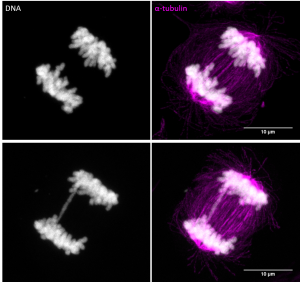CARD researchers rewrite the textbooks; discover hidden mechanism in cell division
With a newly developed technique, researchers from the DNRF Center of Excellence CARD at the Danish Cancer Society have discovered a hitherto unknown mechanism during human cell division. The discovery is startling as it provides a new understanding of cell division, and the results can thus be of great importance for future research into a number of diseases. The study was recently published in the scientific journal Nature Communications.

A team led by researchers from the DNRF Center for Autophagy, Recycling and Disease (CARD) at the Danish Cancer Society has discovered that so-called lysosomes – small organelles that are full of acid and enzymes – have a hitherto unknown function during human cell division. The discovery was made with a new technique the researchers themselves developed. The result is startling and can be important for future research into several diseases.
“We now have a whole new understanding of what happens when cells divide. This knowledge can be important for research into a variety of diseases, from cancer that may be due to errors in DNA sharing, to neurological diseases that are caused by errors in the lysosomes of cells,” explained Professor Marja Jäättelä, who is the center director at CARD and one of the main authors of the study, recently published in the scientific journal Nature Communications.
The lysosomes are known as the sanitation workers of the cells as they cause waste to break down in the cells. But the recent study from Professor Jäättelä and the rest of the CARD research team shows that the lysosomes also adhere closely to the cell’s nucleus during cell division. Here, during a few seconds, they release a breath of enzymes through their membrane. The enzymes are then able to cut the parts of the new and old copy of the DNA that are still connected. The breath from the lysosomes is precisely organized, and without this proper timing, the separation of the DNA can occur prematurely and before the cell is ready, which can lead to DNA breakage, which can further lead to a number of serious diseases.
Until now, it has been the researchers ‘opinion that it was important to keep the lysosomes’ membranes intact in normal cells, as a broken membrane means that the contents of the lysosomes flow into the cell, which would presumably kill the cell.
“It is very surprising that the cells not only use the lysosomes in this whole new way, but also that they actually allow the potentially life-threatening containers to come close to some of the most sensitive areas of the cell – the DNA. It must require extensive regulation to ensure that this process is done correctly, and that is one of the things we now want to study further,” said Jonathan Lucien Stahl, Ph.D. student at CARD and one of the main authors behind the study.
The Scientific article can be found in Nature Communications here
